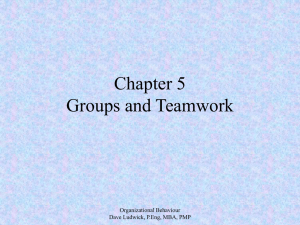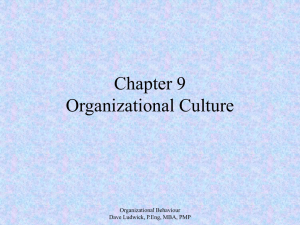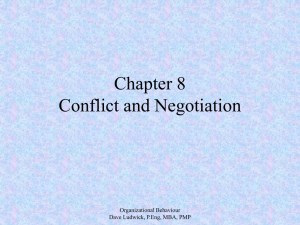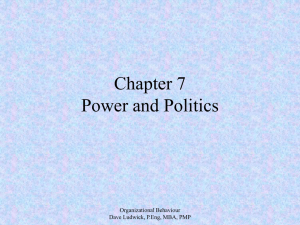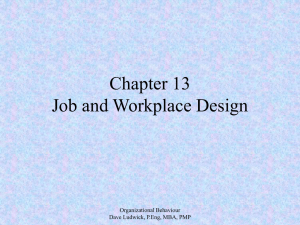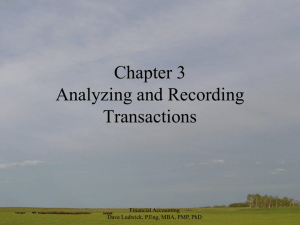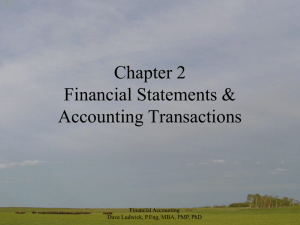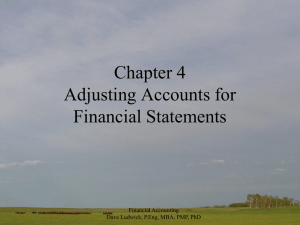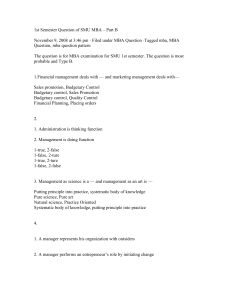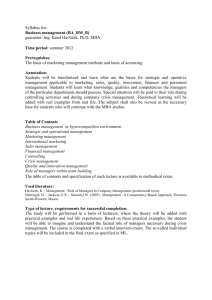Organizational Structure
advertisement
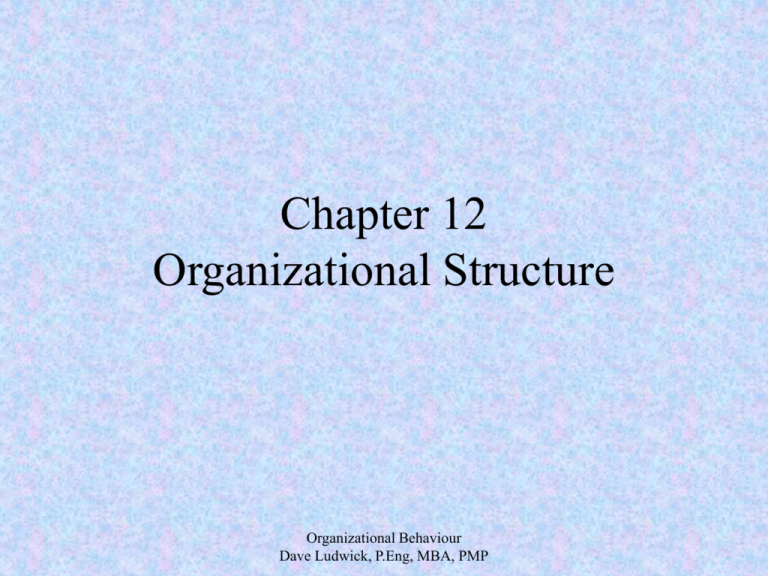
Chapter 12 Organizational Structure Organizational Behaviour Dave Ludwick, P.Eng, MBA, PMP Organizational Structure • Organizational Structure – defines how job tasks are formally divided, grouped and coordinated – The organization structure determines reporting relationships and helps to clarify individuals’ responsibilities • When designing an organization structure, managers consider 6 elements – – – – – – Work specialization Departmentalization Chain of command Span of control Centralization/decentralization formalization Organizational Behaviour Dave Ludwick, P.Eng, MBA, PMP Work Specialization • Work can be performed more efficiently if employees are allowed to specialize • Henry Ford was the first to really explore specialization, allowing him to turn out many new cars a day from it • Specialization is the degree to which tasks are subdivided into separate jobs (the task of assembling an engine) – Allows employees to improve through repetition • Pay scales often reflect the degree of skills required for a job. Employees acquire new skills to earn more • Specialization also encourages the development of specialized tools to further drive efficiency • Specialization can lead to boredom, fatigue, stress, and lower productivity and quality • Building teams of interchangeable skills can help to reduce boredom Organizational Behaviour Dave Ludwick, P.Eng, MBA, PMP Departmentalization • Departmentalization – is a basis on which jobs re grouped to coordinate common or linked tasks • 5 Key Types of Departmentalization – Functional – orienting groups by similar task (engineering dept) – Product – operating a group oriented around a complete product (Business Units are similar when the group owns the P&L) – Geographic – Common in Sales organizations, organizing by territory – Process – Orienting around a portion of a process (most common in a manufacturing firm, such as finishing dept, procurement dept) – Customer – Orienting around types of customers (Corel organizes around retail, small business, corporate, government, legal) • You can have more than one type of departmentalization in a business – Sales by territory, Marketing by product, Manufacturing by process Organizational Behaviour Dave Ludwick, P.Eng, MBA, PMP Chain of Command • Chain of command – the unbroken line of authority from the top to the bottom of the organization • Defines who has the right to give out orders and expect them to be obeyed • Currently, this element of structuring organizations is used less • Teams have been empowered to carry out specific tasks Organizational Behaviour Dave Ludwick, P.Eng, MBA, PMP Span of Control • Span of Control – refers to the number of levels and managers an organization has • All things equal, generally, the wider or larger the span, the more efficient. Wider spans also encourage more employee empowerment • However, managers cannot manage an infinite number of employees effectively (general rule is 6 to 18 employees) Organizational Behaviour Dave Ludwick, P.Eng, MBA, PMP Centralization/decentralization • Centralization – the degree to which decision making is concentrated at a single point in the organization • The more decisions made by top brass without consulting employees, the more centralized • Decentralization is a growing trend to leverage front line employees’ proximity to the action. – Increases empowerment and job satisfaction – Improves quality of decision making – Allows senior management to concentrate on more strategic matters Organizational Behaviour Dave Ludwick, P.Eng, MBA, PMP Formalization • Formalization – the degree to which jobs within the organization are standardized • Formalization provides structure and can build quality but takes away control and decision making • Formalization is used most often in the food, airline, automotive industries • Read the Ethical Dilemma Exercise (p 489), as a class lets discuss the 3 questions Organizational Behaviour Dave Ludwick, P.Eng, MBA, PMP Common Organization Structures • Now that we know the elements that are considered when designing an organization, what are the 3 most common structures used • 3 Most commonly used structures are – The Simple Structure (for small businesses) – The Bureaucracy (for large or government organizations) – The Matrix (for agile companies) Organizational Behaviour Dave Ludwick, P.Eng, MBA, PMP The Simple Structure • Most commonly used in small structures, it is almost the default structure when no specific thought is put into it • Characterized by – – – – low degree of departmentalization, wide spans of control, authority centralized to one person (the owner), with little formalization • The outcome is a flat structure, fast, simple, clear, flexible • This structure gives a small company that “small company feel”. – But it is very difficult to maintain once the company grows and owners cannot directly impact every decision Organizational Behaviour Dave Ludwick, P.Eng, MBA, PMP The Bureaucracy • Characterized by – Standardization of tasks and processes (filling out forms, you guessed it, paper forms!!!, aaahhh) – Highly routine tasks, specialization with formalized rules – Centralized authority and clear vertical communication lines • This structure strives for efficiency, economies, minimum duplication of tasks • It does well when individual employees leave the organization as it is easy to train new staff on established processes Organizational Behaviour Dave Ludwick, P.Eng, MBA, PMP The Matrix • A very popular organization structure in the high-tech world • Combines the benefits of functional and product departmentalization forms • Functional specialists are grouped together to forma pool of resources (developers, testers, documentation specialists) • Product departments (or Business Units), responsible for the complete product, draft individuals from their pools onto product teams • Employees end up with 2 bosses • Ads: Promotes product ownership and specialization • Disads: Confusion, power struggles, stress on employees Organizational Behaviour Dave Ludwick, P.Eng, MBA, PMP Questions • Innovation is key to a organization’s future – What structure works best for an innovation strategy? • How do you think an organization’s structure might be affected by the adoption of technology? • Consider one of the big 3 auto-makers. What type of organization structure to we think they have? Organizational Behaviour Dave Ludwick, P.Eng, MBA, PMP Structural Designs of the st 21 Century • The Team – Usually cross-functional teams with a specific set of goals, helps to break down barriers and decentralizes decision making to the team level • The Modular Organization – A small core organization which outsources major business functions, relying on a network at the organizational level – Teams are assembled for a finite period, then disband – Ex: an ad agency which outsources its printing, accounting, purchasing to concentrate on creative design • The Virtual Organization – Similar to a modular organization, except that in this case, business partners also seek to share skills, costs and tap into each others markets – Akin to developing alliances to provide full service solutions Organizational Behaviour Dave Ludwick, P.Eng, MBA, PMP Why do Organization Structures differ? • Strategy – structures are a means through which organizations try to achieve their goals – It is also a means through which they respond to environmental change • Organization Size – As organizations grow, different stresses are placed on the organization, as a result it might respond with a reorganization of resources • Environment – The organizational environment is made up of institutions or forces outside the organization that affect its ability to perform • Chapter 13 Organizational Behaviour Dave Ludwick, P.Eng, MBA, PMP Organizational Behaviour Dave Ludwick, P.Eng, MBA, PMP Organizational Behaviour Dave Ludwick, P.Eng, MBA, PMP
